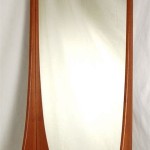DIY Faux Antique Mirror
Creating a faux antique mirror is a popular DIY project that allows one to achieve the aged, elegant look of an antique mirror without the hefty price tag. This effect is achieved by applying various solutions to a standard mirror, causing the reflective backing to tarnish and produce a mottled, aged appearance. This process can be tailored to achieve a range of antique effects, from subtle weathering to heavily distressed patinas.
Choosing the Right Mirror
The starting point for any faux antique mirror project is the mirror itself. While any new mirror can be used, considering the frame and overall design helps integrate the final product seamlessly into the desired space. A simple, flat frame often provides the best canvas for the antiquing process. Beveled edges can add to the vintage charm, and choosing a frame material that complements the desired antique finish enhances the overall aesthetic. For example, a dark wood frame pairs well with a heavily antiqued mirror, while a lighter frame might suit a more subtly aged look.
Preparing the Mirror Surface
Proper surface preparation is crucial for achieving a successful and even antique finish. The mirror surface needs to be thoroughly cleaned and degreased to ensure the antiquing solution adheres correctly. This can be accomplished using a glass cleaner followed by a thorough rinse with clean water. It is important to avoid leaving any residue from the cleaning products, as this can interfere with the antiquing process and lead to uneven results. Allow the mirror to dry completely before proceeding to the next step.
Applying the Antiquing Solution
Several different solutions can be used to create the antique effect, each producing slightly different results. Some popular options include a mixture of vinegar and water, a solution of hydrochloric acid and water (requiring careful handling due to the acid's corrosive nature), or commercially available antiquing solutions specifically designed for mirrors. The chosen solution is applied to the mirror’s reflective backing, typically in a spray bottle to achieve an even distribution. The application method can influence the final look, with layering and dabbing techniques creating more textured effects.
Creating Different Antique Effects
The level of antiquing can be controlled by the concentration of the solution, the application method, and the number of layers applied. For a subtler, aged look, a diluted solution and a single application might suffice. For a more dramatic, heavily antiqued appearance, a stronger solution and multiple layers, potentially combined with dabbing or blotting techniques, can be employed. Experimentation on a small, inconspicuous area of the mirror is advisable to determine the desired effect before applying the solution to the entire surface.
Protecting the Antiqued Finish
Once the desired antique effect is achieved and the solution has dried completely, it is important to protect the finish to ensure its longevity. Applying a sealant, such as a clear acrylic spray or varnish, creates a protective barrier against moisture and other environmental factors that could damage the antique finish. This protective layer also helps to prevent further tarnishing and maintains the desired level of antiquing.
Safety Precautions
When working with any chemicals, including those used in antiquing solutions, it is crucial to prioritize safety. Always wear appropriate protective gear, such as gloves and eye protection. Ensure adequate ventilation in the workspace to avoid inhaling fumes. If using hydrochloric acid, exercise extreme caution due to its corrosive nature, and carefully follow the manufacturer’s instructions. Dispose of any leftover solution responsibly and in accordance with local regulations.
Alternative Antiquing Techniques
Beyond chemical solutions, other techniques can be employed to achieve an antique mirror effect. These include using specialized paints designed to create a weathered appearance or applying a layer of tinted varnish to the back of the mirror. These methods offer greater control over the final color and texture of the antique finish and can be particularly useful for achieving specific design aesthetics. They also often present a less hazardous alternative to working with chemical solutions.

The Ultimate Guide On Diy Antique Mirrors So Much Better With Age

Diy Antique Mirror Easy To Do And Looks Authentic My Creative Days

Diy Faux Antiqued Mirror No Chemicals Antique Anthropologie Home

The Ultimate Guide On Diy Antique Mirrors So Much Better With Age

How To Create A Faux Antique Mirror From Picture Frame Jennifer Rizzo

How To Antique A Mirror Tutorial Jenna Sue Design

Exude Parisan Style With A Diy Vintage Inspired Faux Brass Mirror Decoist

Diy Mercury Glass Gilded Mirror Made From Old Photo Frames

How To Antique A Mirror From The Front With Paint Average But Inspired

How To Antique A Mirror 9 Fast Diys Shelterness








